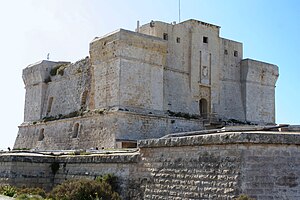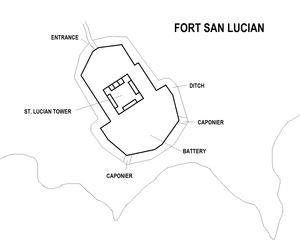| Fort San Lucian | |
|---|---|
Forti San Luċjan | |
| Part of the Wignacourt towers | |
| Marsaxlokk, Malta | |
 St Lucian Tower, the oldest part of Fort San Lucian | |
 Map of Fort San Lucian as it is today | |
| Coordinates | 35°49′49.8″N 14°32′35.5″E / 35.830500°N 14.543194°E |
| Type | Bastioned coastal watchtower Artillery battery Polygonal fort |
| Site information | |
| Controlled by | Malta Aquaculture Research Centre |
| Open to the public | No |
| Condition | Intact |
| Site history | |
| Built | 1610–1611 (tower) 1715 (battery) 1792–1795 (first fort) 1872–1878 (second fort) |
| Built by | Order of Saint John (tower, battery and first fort) British Empire (second fort) |
| In use | 1610–1885 |
| Materials | Limestone |
| Battles/wars | Raid of Żejtun (1614) French invasion of Malta (1798) Siege of Malta (1798–1800) |
Fort San Lucian (Maltese: Forti San Luċjan), also known as Saint Lucian Tower (Maltese: Torri ta' San Luċjan) or Fort Rohan (Maltese: Forti Rohan), is a large bastioned watchtower and polygonal fort in Marsaxlokk, Malta. The original tower was built by the Order of Saint John between 1610 and 1611, being the second of six Wignacourt towers.
An artillery battery was added around 1715, and the complex was upgraded into a fort in the 1790s. In the 1870s, the fort was rebuilt by the British in the polygonal style. Saint Lucian Tower is the second largest watchtower in Malta, after Saint Thomas Tower. Today, the tower and fort are used by the Malta Aquaculture Research Centre.